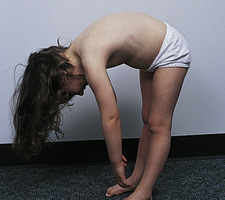• Your notes should include a description of the child’s behavior and the nature of the relationship during interactions with parent (or caregiver) and with you. • Offer toys or paper and crayons to entertain child (if age appropriate), to develop rapport, and to evaluate development and neurologic status. Attempt to gain child’s cooperation, even if it takes more time; future visits will be more pleasant for both of you. • Only if absolutely necessary, restrain child for funduscopic, otoscopic, oral examinations; restraint is easier on an adult lap with the aid of the adult. • Lessen fear of these examinations by permitting child to handle instruments, blow out light, or use them on a doll, a parent, or yourself. • Take and record temperature, weight, length, or height; also take blood pressure (record extremity or extremities used, size of cuff, and method used). • Note percentiles for all measurements, including body mass index for children ≥2 years. • If clinical issues require it, include arm span, upper segment measurement (crown to top of symphysis), lower segment measurement (symphysis to soles of feet), upper/lower segment ratio, and chest circumference. • Review parent-completed developmental screening tool to assess language, motor abilities, and social skills. • Evaluate mental status as child interacts with you and parent. • While child plays on the floor, evaluate musculoskeletal and neurologic system while developing a rapport with child. • Observe child’s spontaneous activities. • Ask child to demonstrate skills: turning pages in a book, building block towers, drawing geometric figures, coloring. • Evaluate gait, jumping, hopping, range of motion. • Muscle strength: Observe child climbing on parent’s lap, stooping, and recovering. • Perform examination on parent’s lap; the adult and the patient generally enjoy the experience more, and you, sitting on a stool, preferably with your eyes at the child’s eye level, will find it easier than the examining table. • Begin with child sitting and undressed except for diaper or underpants. • Inspect shape, alignment with neck, hairline, eyelids, palpebral folds, conjunctivae, sclerae, irides, position of auricles. • Palpate anterior fontanel for size (age appropriate); head for sutures, depressions; hair for texture. • Measure head circumference (up to age 36 months). • Inspect neck for webbing, voluntary movement. • Palpate neck: thyroid, muscle tone, lymph nodes, position of trachea. • Inspect chest for respiratory movement, size, shape, precordial movement, deformity, nipple and breast development. • Palpate anterior chest, locate point of maximal impulse. • Auscultate anterior, lateral, and posterior chest for breath sounds; count respirations. • Auscultate all cardiac listening areas for S1 and S2, splitting, murmurs; count apical pulse. • Inspect eyes: pupillary light reflex, red reflex, corneal light reflex, extraocular movements, funduscopic examination. • Perform otoscopic examination. Note position and description of pinnae. • Inspect mouth and pharynx. Note number of teeth, deciduous or permanent, and any special characteristics. • Social: sleeping arrangements, housing • Maternal mood and social support • Umbilicus: healing, discharge, granulation • What risks have revealed themselves as you have gotten to know the family? What are apparent problems? Start a problem list and make appropriate dispositions. • Review results of newborn metabolic screening. • Consider immunization needs and, throughout, attempt to follow American Academy of Pediatrics guidelines; on each visit, discuss benefits, risks, and side effects of immunizations (always remember risks for the immunocompromised). • Expressions of parental concern • Child’s apparent temperament • Stooling pattern, frequency, color, consistency, straining • Feeding (delay or at least downplay solids; avoid citrus, wheat, mixed foods, eggs; minimize water) • When and if mother returns to work • Visual and auditory stimulus (mobiles, mirrors, rattles, singing and talking to baby) • Sibling rivalry (if there are siblings or other children in home) • Babysitters and other caregivers (checking references, reliability) • Safety (rolling over, playpen, car seat, smoke detectors in home) • Sleep (re-emphasize location and supine position) • Introduction of solid food (cereal) • Stool changes with changes in diet • Thumb sucking, pacifiers, bottles at bedtime • Safety (aspiration, rolling over, holding baby with hot liquids, re-emphasize earlier discussions [e.g., car seat]) • Re-emphasis on environmental stimulus • Further discussion of babysitters and other caregivers
Age-Specific Examination
Infants, Children, and Adolescents
Examination Guidelines
Child Playing
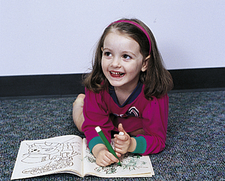
Child on Parent’s Lap
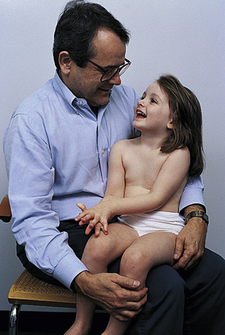
Head and Neck
Chest, Heart, Lungs
Child Relatively Supine, Still on Lap, Diaper Loosened
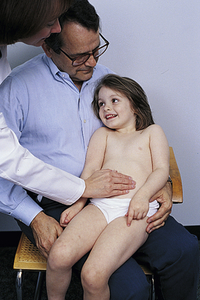
Child on Parent’s Lap
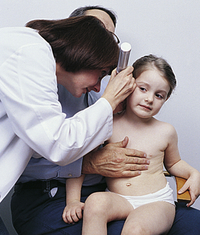
Age-Specific Anticipated Observations and Guidelines
2 Weeks of Age
History (particular attention)
Plans and Problems
2 Months of Age
History (particular attention)
Anticipatory Guidance
Development
Anticipatory Guidance
![]()
Stay updated, free articles. Join our Telegram channel

Full access? Get Clinical Tree


Age-Specific Examination: Infants, Children, and Adolescents
Get Clinical Tree app for offline access

